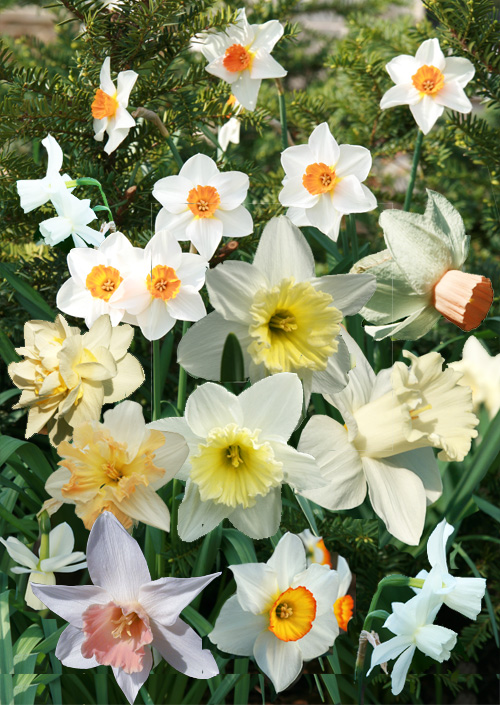
Golden yellow daffodils are an iconic spring flower, but these cheerful flowering bulbs do come in other colors. Numerous cultivars of daffodils are available in various combinations of white, pink and orange, with or without yellow, in intense and pastel shades. Daffodils also come in a variety of flower shapes, bloom times and heights, so there are many choices if you want something other than just a standard yellow daffodil.
Daffodil Classification
Daffodils can be separated into 12 divisions in the current system of classification. This system describes the configuration of the perianth segments (or petals) and the corona (trumpet or cup).
Division 1: Trumpet daffodils of garden origin
One flower per stem, corona as long as or longer than the perianth segments.
Division 2: Large cup shape daffodils of garden origin
One flower per stem. Corona more than one third, but less than equal to the length of perianth segments.
Division 3: Small cupped daffodils of garden origin
One flower per stem. Corona less than one-third the length of the perianth.
Division 4: Double daffodils of garden origin
One or more flower per stem, with doubling of the perianth segments or the corona or both.
Division 5: Triandrus daffodils of garden origin
Two or more pendent flowers to a stem. Perianth segments reflexed.
Division 6: Cyclamineus daffodils of garden origin
Usually one flower to stem. Noted for long trumpets and swept back petals. Flower at an acute angle to the stem, a very short pedicle (neck).
Division 7: Jonquilla daffodils of garden origin
These are known for their perfume, tubular leaves and yellow flowers up to 5 cm across.
Division 8: Tazetta daffodils of garden origin
Bunched flowers, with 3-20 flowers to a short stem. Leaves broad. Flowers are fragrant. Majority of hybrids are tender and used for forcing or container cultivation except in mild climates.
Division 9: Poeticus daffodils of garden origin
These are characterized by the white petals and the flat frilled bright red cup of scented flowers; they usually appear after the other narcissi have finished blooming.
Division 10: Wild forms
This section includes all the wild forms and wild hybrids, all the miniature and less spectacular narcissi. It also includes wild variants with double flowers.
Division11: Split corona daffodils of garden origin
Corona of the flower is split, usually for more than half its length.
Division 12: Miscellaneous daffodils
Those daffodil that do not fall into any one of the above divisions.
The first white daffodils were developed in England in the 1600’s when this wildflower native to Northern Europe began to be grown as a garden flower. Breeders have continued to select and hybridize daffodils ever since. Unfortunately, many white or reverse bicolor cultivars (any with ‘Madame de Graff’ in their ancestry) are very susceptible to root rot, so do not perform as well as many yellow types. White daffodils have been developed within nearly all of the divisions.
All white daffodils may not have the same colorful punch as yellow ones but they can be a stylish addition to many gardens. Many of these cultivars have names reflecting the similarity of their color to the ice and snow of winter, even though most of us are ready to leave all that behind by the time spring-flowering bulbs come into bloom.

Some all white cultivars include:
- ‘Cassata’ is a Division 11 cultivar considered all white, even though the corona has yellow in it. The split cup is bright yellow when the flower opens but that turns to white after a couple of days. It is very floriferous, easy to force and equally good in the garden.
- ‘Ice Wings’ offers multiple small flowers per stem, each with long trumpets and reflexed petals. This reliable Division 5 selection grows about 12″ tall.
- ‘Jenny’ is a good Division 6 garden performer with milky-white petals and a yellow trumpet when it first opens, but quickly fades to creamy white. This short selection (8-10″) blooms in early spring.
-

‘Mt. Hood’ daffodil.
‘Misty Glen’ is a pearlescent white with a green eye deep inside the cup. This sturdy, late-blooming English-bred Division 2 cultivar introduced in 1976 also makes excellent cut flowers. - ‘Mount Hood’ is an older (around since the 1930s) but still popular all-white cultivar with long trumpets. Some flowers may start a very pale yellow but quickly fade to white, especially in full sun. This reliable Division 1 daffodil grows 10-16″ tall and blooms in mid-spring.
-
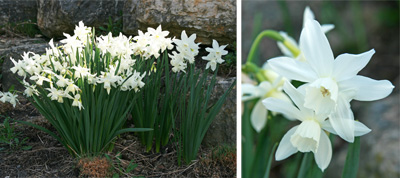
‘Thalia’ daffodil.
‘Thalia’ is a triandrus type (Division 5) with one to three pure white flowers per stem in mid-spring. The delicate pendant flowers have narrow petals and a small cup. The 10-16″ plants look best planted in groups and tend to perennialize well. This cultivar is an heirloom variety that is among the few daffodils that grow well in the Deep South.
Some examples of cultivars with white perianth segments and yellow or orange coronas include:
-

‘Actea’ daffodil.
‘Actea’ is a popular cultivar from Division 9, with large, flat white perianth segments and a shallow yellow cup with a red edge. These are fragrant with a very sweet scent and are good for cutting.

‘Ice Follies’ daffodil - ‘Ice Follies’ is a 10-12″ tall Division 2 daffodil with large flowers. The broad flattened cup is frilly or crinkled on the edges, with the creamy, lemon-yellow color fading to white when mature. It is good for forcing or naturalizing, and blooms in mid spring.
- ‘Ice King’ is essentially a double form of ‘Ice Follies’ with the same pure white perianth but double lemon-yellow corona. The pleated trumpet also fades with age to a creamy white.
-
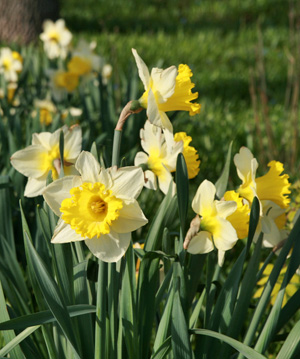
‘Las Vegas’ daffodil.
‘Las Vegas’ is very similar to ‘Ice Follies’ but with a longer and darker yellow trumpet. This Division 1 cultivar has fragrant flowers on plants 18-24″ tall. - ‘Sovereign’ is a Division 11 daffodil whose broad, ruffled yellow-orange split-corona almost obscures the white perianth. This is an improvement over the well-known ‘Orangery’, with bigger flowers and better color and shape.
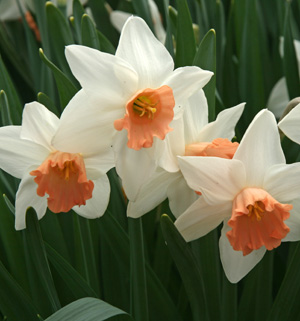
If you want a pink daffodil, you may have to use your imagination, as most of the cultivars described as “pink” in catalogs tend to have a touch of yellow so they are more of an apricot or peach color than true pink (despite the photos). Plant the bulbs in light shade for the best color, as many pink daffodils fade rapidly in full sun. Many companies offer blends or mixes of 5 or more cultivars of pink daffodils. Here are a few cultivars that are readily available with white perianth segments and a pinkish corona:
- ‘Accent’ (right) has a pink to salmon trumpet with a frilly rim that remains strongly colored even in full sun. It is a good naturalizer that grows 16-18″ tall and blooms in mid-spring. It was the winner of the RHS’s Award of Garden Merit in 1995.
- ‘Bell Song’ produces two fragrant flowers per stem with pink cups. It grows 8-14″ tall and makes a good cut-flower in late spring.
- ‘Mrs. R.O. Backhouse’ is an heirloom daffodil, introduced in 1921, as the first pink cultivar. It was developed by Englishman Robert O. Backhouse who named it for his wife and fellow daffodil breeder, Sarah Elizabeth. The cup is a soft peachy pink that fades with age to a lovely blush.
-
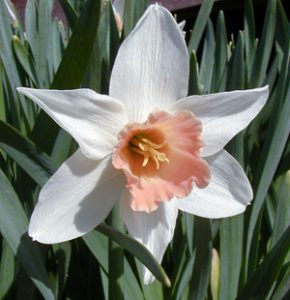
Salomé daffodil.
‘Pink Charm’ offers a soft white ruffled cup rimmed in coral-pink and surrounded by pure white perianth segments. The 3-4″ flowers bloom on 12-16″ plants in mid spring. This variety is good for naturalizing. - ‘Precocious’ is an American-bred cultivar with large, dark rose pink cups. It has won several prizes at the Keukenhof display garden in The Netherlands and is a vigorous grower.
- ‘Replete’ is a double with salmony-pink splotches on the double ruffled corona parts. As with most “pink” varieties, they start out with yellow-orange hues that soften to something closer to rose-pink. Plants grow 12-16″ tall with 4″ wide flowers.
-

‘Berlin’ daffodil.
‘Salomé’ is another older variety with an apricot to coral trumpet. The pastel color, which changes with age, is still nice against the ivory-white perianth. This mid-spring bloomer grows 14-16″ tall.
And if you do want yellow, but not just plain yellow, there are many varieties that combine yellow perianth segments with orange or “red” coronas (“red” daffodils are ones that have orange-red cups):
- ‘Berlin’ has very wide and flattened, frilly, orange-edged cups.
- ‘Fortissimo’ is an extra large Division 2 daffodil with a slightly frilly brilliant deep orange trumpet on 16″ plants.
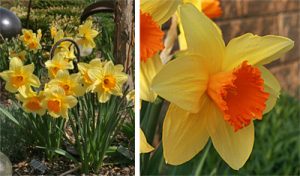
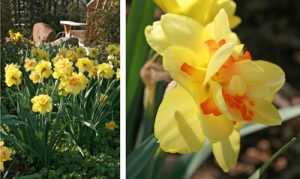
- ‘Tahiti’ is a Division 4 selection with double golden perianth segments and smaller double orange corona.
- ‘Unsurpassable’ is a Division 1 cultivar similar to ‘Fortissimo’
Of course there are many, many other cultivars of daffodils in colors other than yellow besides these mentioned here and new varieties are constantly being developed and offered for sale.

– Susan Mahr, University of Wisconsin – Madison





 Alternatives to Lawn: Groundcovers
Alternatives to Lawn: Groundcovers Marigolds
Marigolds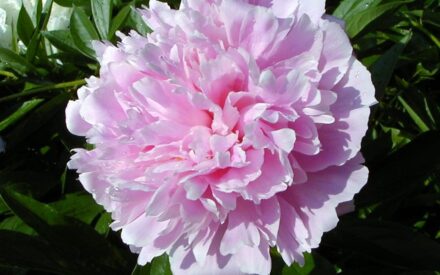 Peony
Peony Iris Severe Mosaic
Iris Severe Mosaic


